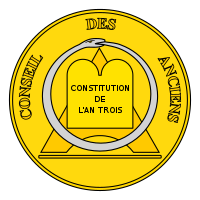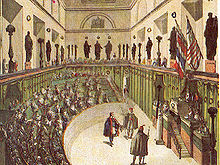

Council of Ancients
Conseil des Anciens
| |
|---|---|
| French First Republic | |

Emblem of the Council of Anciens
| |
| Type | |
| Type | |
| History | |
| Established | 2 November 1795 |
| Disbanded | 10 November 1799 |
| Preceded by | National Convention (unicameral) |
| Succeeded by | Imperial Senate |
| Seats | 250 |
| Meeting place | |
| Salle du Manège, rue de Rivoli, Paris | |


The Council of AncientsorCouncil of Elders (French: Conseil des Anciens) was the upper house of the French legislature under the Constitution of the Year III, during the period commonly known as the Directory (French: Directoire), from 22 August 1795 until 9 November 1799, roughly the second half of the period generally referred to as the French Revolution.
The Council of Ancients was the senior of the two-halves of the republican legislative system. The Ancients were 250 members who could accept or reject laws put forward by the lower house of the Directory, the Council of Five Hundred (Conseil des Cinq-Cents). Each member had to be at least forty years of age, and a third of them would be replaced annually. They had no authority to draft laws, but any bills that they renounced could not be reintroduced for at least a year.[1]
Besides functioning as a legislative body, the Ancients chose five Directors, who jointly held executive power, from the list of names put forward by the Council of Five Hundred. The Council of Ancients had their own distinctive official uniform, with robes, cape and hat, just as did the Council of Five Hundred and the Directors.[2][3] Under the Thermidorean constitution, as Boissy d'Anglas put it, the Council of Five Hundred was to be the imagination of the Republic, and the Council of Ancients its reason.[4][5]
The name adopted for the body was based on the French translation/adaptation of the term Senate.[6]
{{cite book}}: |website= ignored (help)